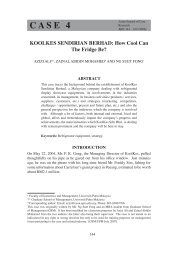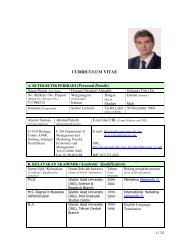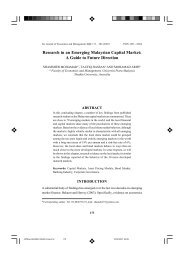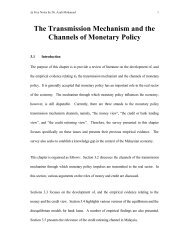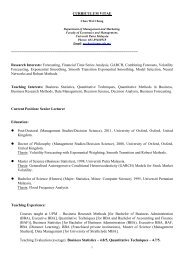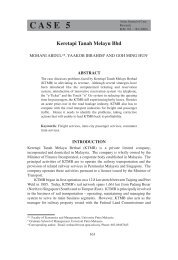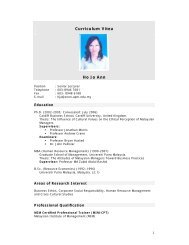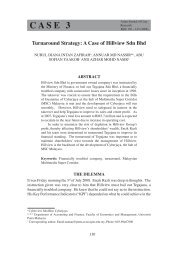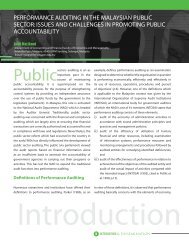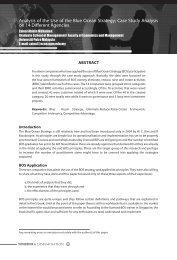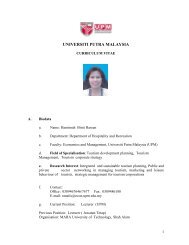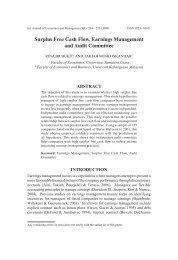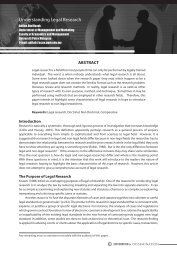Accounting Stress for Success - Universiti Putra Malaysia
Accounting Stress for Success - Universiti Putra Malaysia
Accounting Stress for Success - Universiti Putra Malaysia
You also want an ePaper? Increase the reach of your titles
YUMPU automatically turns print PDFs into web optimized ePapers that Google loves.
<strong>Accounting</strong> <strong>Stress</strong> <strong>for</strong> <strong>Success</strong>: The Ergonomics Perspective<br />
Hasri Mustafa<br />
Department of <strong>Accounting</strong> and Finance<br />
Faculty of Economics and Management<br />
<strong>Universiti</strong> <strong>Putra</strong> <strong>Malaysia</strong><br />
E-mail: m.hasri@econ.upm.edu.my<br />
Abstract<br />
Often stress appears to be a hindrance of success. There are various stress management<br />
examples of how particular per<strong>for</strong>mances obstruct to conflicting factors such as role<br />
conflicts and role ambiguities. However, a concern with how individuals stress their<br />
stress so as to account the events to withstand as a specified success person is not<br />
widely written. This paper, arguing from the ergonomics perspective, advocates the<br />
view. It details the accounting of stress as a means of reaction and reciprocation of<br />
physical changes and other elements of human well-being system, hence operating as<br />
a source to success.<br />
Keywords: <strong>Stress</strong>, Account, Ergonomics, <strong>Success</strong><br />
Introduction<br />
<strong>Stress</strong> is argued to implicate in a wide set of occupations and professions. A great deal of research has<br />
examined the construct of it on role conflict and role ambiguity (<strong>for</strong> e.g. Chang & Chang, 2007; Schaubroeck,<br />
Cotton & Jennings, 1989). Stemmed from psychological, biological and social causes, the term “stress” has<br />
been in such common usage that it has taken on a variety of meanings. Following Aldwin (1994), “stress<br />
refers to that quality of experience, produced through a person-environment transaction, that through<br />
either overarousal or underarousal, results in psychological and physiological distress” (p. 22.)<br />
Considerable theory and research have argued that while the common emotional reactions to stress<br />
generally refer to negative feelings such as anxiety, anger, and sadness, some attentions have been paid to<br />
growth and positive personal changes (Folkman & Moskowitz, 2004). For instance, according to Fogarty,<br />
Singh, Rhoads, and Moore (2000), role overload of memberships in the American Institute of Certified<br />
Public accountants is not a significant influence on job satisfaction. This may lead to the conclusion that<br />
role overload is a less critical role stressor (see p. 60). As <strong>for</strong> other fields such as nursing and the practice of<br />
medicine, the result is vice versa (see Berland, Natvig & Gundersen, 2008).<br />
One effect of such inconsistent findings have induced researchers to reexamine the very basic<br />
question: whether stress is a fact or myth. This essay extents this view with the relationship of stress and the<br />
development of future career. It discusses the accounting of stress as a stimulus, and is a key to success. The<br />
question of whether it is a fact or myth is detailed based on the arguments developed from the ergonomics<br />
perspective. The term “ergonomics” is taken from the Greek word ergon, which means “work” and “natural<br />
laws”. It is also called human engineering as it studies human capabilities in relationship to their tasks,<br />
products, environments and systems that are compatible with the needs, abilities and limitations of<br />
people.<br />
<strong>Accounting</strong> <strong>Stress</strong> <strong>for</strong> <strong>Success</strong><br />
Measuring stress entails measurement of live events (cf. Aldwin, 1994). In so doing, previous research has<br />
come up with methods such as clinical interviews (e.g. Gould, Hussong & Keeley, 2008), laboratory stressors<br />
(e.g. Al-Fudail & Mellar, 2008), intelligence and working memory capacities (e.g. Brewin & Beaton, 2002).<br />
Any remaining errors or omissions rest solely with the author(s) of this paper.<br />
1<br />
INTEGRATION & DISSEMINATION
The above scholars agree that the temporal parameters of the study and the type of stress outcomes being<br />
assessed should guide the choice of stress measure. For stress to be associated with positive outcomes,<br />
people often find that success is the most debatable feature. It is because, success is epistemologically<br />
privileged (Maslow, 1987).<br />
The meaning of success comes in many <strong>for</strong>ms, and many definitions. It depends on what you are<br />
accounting <strong>for</strong> in life, and accounting <strong>for</strong> in hereafter. Ashar and Lane-Maher (2004) found success in the<br />
spirituality virtues, ranging from money, property, positional power, and status symbols. For them, when<br />
a person conducts himself to include or excuse from responsibility he ordinarily impute some measure of<br />
<strong>for</strong>esight of his actions so that to “account” the events going on around him (see also Meyer, 1986; Scott &<br />
Lyman, 1968). <strong>Accounting</strong> stress in success terms offers a means by which the actions and achievements of<br />
individuals may be standardized and compared. This is because, by doing so, particular ways are created by<br />
which individual may be thought about, controlled and directed, and acted upon (cf. Potter, 2005).<br />
An example of the <strong>for</strong>egoing description is accounted by Jerrold S. Greenberg in his book Comprehensive<br />
<strong>Stress</strong> Management (1993). It provides insights that success and stress are inextricably intertwined, where<br />
stress functions as a stimulus to success.<br />
My life changed rapidly and repeatedly. I came to Buffalo as an assistant professor and was<br />
promoted twice, leaving as a full professor with tenure and administrative responsibility <strong>for</strong> the<br />
graduate program in health education. When I left Buffalo, I had published over <strong>for</strong>ty articles in<br />
professional journals, and my second book was soon to come off the press. During my tenure<br />
at SUNY/Buffalo, I appeared on radio and television programs and was subject of numerous<br />
newspaper articles. I came to Buffalo and there bought my first house, fathered my two children,<br />
and won my first tennis tournament. In short I became a success. So why the vomiting I was<br />
experiencing too much change in too short a period of time. I wondered about embarrassing<br />
myself in front of other people and became extremely anxious when due to speak in front of a<br />
large group-so anxious that a nice spring day, about seventy degrees, with the sun shining and<br />
a slight breeze, as I was on my way to address a group of teachers, school administrators, and<br />
parents in Wheatfield, New York, I became sick to my stomach. I pulled the car off the road, jumped<br />
out, vomited, jumped back in, proceeded to Wheatfield, and presented a one-hour speech which to<br />
this day is still not remembered by anyone who was there. What I didn’t know then, but know now,<br />
is that I was experiencing stress-too much stress (1993, p. 3-4, emphasis added)<br />
Note that the above two clauses that have underscored are success and experiencing stress-too much stress.<br />
The <strong>for</strong>mer, <strong>for</strong> which constructions such as “promoted”, “published”, and “appeared” amalgamate with,<br />
has shown that: it is success that is an antecedent of stress. A preceding occurrence, cause, or event of<br />
promotion, publication and appearance had caused Greenberg to account through looking at where he<br />
was presently, had he failed in any of his endeavours And how long did Greenberg take to achieve what<br />
he has In this sense it is success that constitutes the conception of stress. The central argument is it is “an<br />
experience that arises from a transaction between a person and the environment” that defines the stress<br />
(Aldwin, 1994, p. 23, quoted Mason, 1975). It is success that arises from a transaction between Greenberg<br />
and his environment.<br />
Although it is equally possible that stress may have an antecedent effect, much of the work in stress<br />
acknowledges that stress effects are highly probabilistic phenomena, being very dependent upon a myriad<br />
of contextual and personal factors. To interpret, we all know that the same situation presented here to<br />
different people may result in different reactions. That is because different people will interpret the situation<br />
differently. This, according to Greenberg, is termed as “cognitive appraisal” (1993) which can be controlled.<br />
At this point, we need some in<strong>for</strong>mation about ourselves as a stimulus to infer the success meaning. The<br />
success interpretation might include successes such as Greenberg’s experiences: was promoted twice,<br />
leaving as a full professor with tenure and administrative responsibility <strong>for</strong> the graduate program in health<br />
education. This success view is seen as competing and winning. This structure reflects the concept of the<br />
INTEGRATION & DISSEMINATION 2
ational individual that stress is not only had to be thought up by the success, but also needs to be regarded<br />
as a stimulus of success.<br />
The Ergonomics of <strong>Stress</strong><br />
As can be read from the reflections of Greenberg, there are some parts of Greenberg’s body that changed<br />
when he was distressed, which wrote: I became sick to my stomach. I pulled the car off the road, jumped<br />
out, vomited, jumped back in, proceeded to Wheatfield, and presented a one-hour speech which to this day<br />
is still not remembered by anyone who was there. All of these were in the <strong>for</strong>m of “ergonomics”, on the basis<br />
of the interplay of “work” and “natural laws”. Like many of the “reality series” in television it is neither the<br />
size of the audiences nor the amount of income collected from advertisement that makes the audiences<br />
feel anxious, worried, etc. (stress), but when the self-presentations of actor counteract undesirable or<br />
problematic experiences as a means of reaction and reciprocation, that is when the actor accomplish,<br />
attain, etc. (success) in provoking the emotional charge. In the case of Greenberg, beginning to think of<br />
stress in terms of his journey, may be proceeded to how he had previously thought about success.<br />
Similarly, if in the show, the hypnotist asks the man to follow the pendulum like movement of his<br />
chained watch as he slowly and softly mutters, and the man paused <strong>for</strong> a moment, took a deep breath,<br />
focusing on what he is capable to do, <strong>for</strong> Greenberg, what seems to be an adverse reaction of digestive<br />
system (i.e. vomiting), is inasmuch as to defend him “from being harmed by bacteria, viruses or other<br />
poisonous substances” (Tengland, 2001, p. 85). As a university professor, Greenberg accepts that the more<br />
rapidly knowledge and in<strong>for</strong>mation climates change, the greater the need <strong>for</strong> responsive dynamic learning<br />
models. <strong>Stress</strong> takes place of him in response to such environmental demands or pressures. However, his<br />
“defense” human body systems were utilized in order to “fight off” so as to withstand as a specified success<br />
person.<br />
Concluding Thought<br />
The term “managing stress” is common in our live. There are various stress management examples of how<br />
particular individuals give attention to conflicting factors such as role conflicts and role ambiguities. A<br />
number of related theoretical concepts and developments have been instrumental in expanding current<br />
knowledge of stress. This includes attempts to link management techniques according to notions of a<br />
negative relationship between stress and job per<strong>for</strong>mance (e.g. Collins and Killough, 1992; Cooper, 1980;<br />
Viator, 2001, to name a few). However, in reality, many routine actions are more salient to others and<br />
they might react differently. A concern with how individuals stress their stress so as “to be accountable”<br />
(Garfinkel, 1967) is not widely written. Consideration needs to be given to ways of accounting the stress<br />
consequences of alternative <strong>for</strong>ms of organizing success. Rather than seeing stress with the myths of higher<br />
role ambiguity and role conflict, ones should see it with their heart pounding faster, muscles tightening,<br />
blood pressure rising, breath quickening, and brain senses sharpening. These physical changes increase<br />
strength and stamina, speed reaction time, and enhance focus, preparing to fight with the understanding<br />
of interactions among humans and other elements of a system in order to optimize human well-being and<br />
overall system – the ergonomics approach.<br />
References<br />
Aldwin, C. M. (1994) <strong>Stress</strong>, Coping, and Development: An Integrative Perspective, The Guil<strong>for</strong>d Press: New<br />
York<br />
Al-Fudail, M., and Mellar, H. (2008) Investigating Teacher <strong>Stress</strong> When Using Technology, Computers &<br />
Education, 51(3): 1103-1110.<br />
Ashar, H., and Lane-Maher, M. (2004) <strong>Success</strong> and Spirituality in the New Business Paradigm, Journal of<br />
Management Inquiry, 13(3): 249 - 260.<br />
Berland, A., Natvig, G. K., and Gundersen, D. (2008) Patient Safety and Job-Related <strong>Stress</strong>: A Focus Group<br />
Study, Intensive and Critical Care Nursing, 24(2): 90-97.<br />
3<br />
INTEGRATION & DISSEMINATION
Brewin, C. R., and Beaton, A. (2002) Thought Suppression, Intelligence, and Working Memory Capacity,<br />
Behaviour Research and Therapy, 40(8): 923-930.<br />
Chang, T-Y, and Chang, Y-L. (2007) Relationship Between Role <strong>Stress</strong> and Job Per<strong>for</strong>mance in Salespeople<br />
Employed by Travel Agents in Taiwan, International Journal of <strong>Stress</strong> Management, 14(2): 211-223.<br />
Fogarty, T. J., Singh, J., Rhoads, G. K., and Moore, R. K. (2000) Antecedents and Consequences of Burnout in<br />
<strong>Accounting</strong>: Beyond the Role <strong>Stress</strong> Model, Behavioral Research in <strong>Accounting</strong>, 12: 31-67.<br />
Folkman, S., and Moskowitz, J. T. (2004) Coping: Pitfalls and Promise, Annual Review of Psychology, 55: 745-<br />
774.<br />
Garfinkel, H. (1967) Studies in EthNomethodology, Prentice Hall: New Jersey<br />
Gould, L. F., Hussong, A. M., and Keeley, M. L. (2008) The Adolescent Coping Process Interview: Measuring<br />
Temporal and Affective Components of Adolescent Responses to Peer <strong>Stress</strong>, Journal Of Adolescence,<br />
31(5): 641-657.<br />
Greenberg, J. S. (1993) Comprehensive <strong>Stress</strong> Management, Wm. C. Brown Communications, Inc:New York<br />
Maslow, A. H. (1987) Motivation and Personality, (3 rd edn), Harpercollins Publishers: New York<br />
Mason, J. W. (1975) A Historical View of the <strong>Stress</strong> Field, Journal Of Human <strong>Stress</strong>, 1: 6-27.<br />
Meyer, J. W. (1986) Social Environments and Organizational <strong>Accounting</strong>, <strong>Accounting</strong>, Organizations and<br />
Society, 11(4/5): 345-356.<br />
Potter, B. N. (2005) <strong>Accounting</strong> as a Social and Institutional Practice: Perspectives to Enrich Our Understanding<br />
of <strong>Accounting</strong> Change, Abacus, 41: 265-289.<br />
Schaubroeck, J., Cotton, J. L., and Jennings, K. R. (1989) Antecedents and Consequences of Role <strong>Stress</strong>: A<br />
Covariance Structure Analysis, Journal of Organizational Behavior, 10: 55-58.<br />
Scott, M. B., and Lyman, S. M. (1968) Accounts, American Sociological Review, 33(1): 46-62.<br />
INTEGRATION & DISSEMINATION 4



